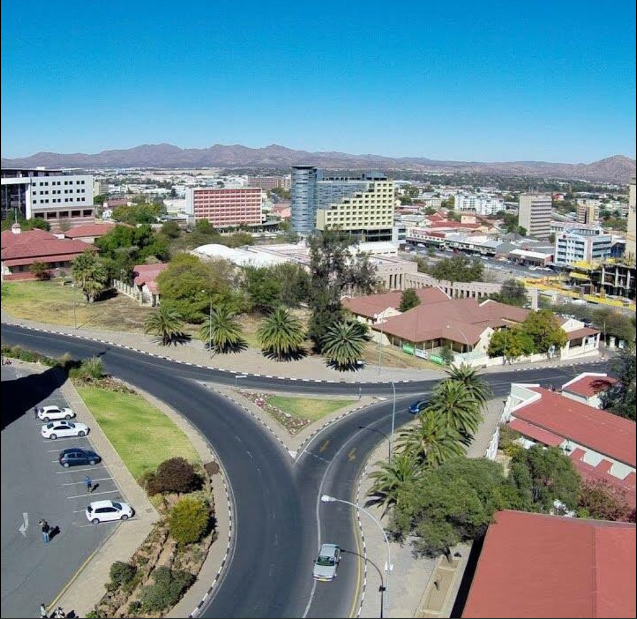Place image

Windhoek is the capital and largest city of the Republic of Namibia. If Namibia is Africa for beginners, then Windhoek is very much its capital in more than name only. It's the sort of place that divides travellers, with those who love it for the respite it offers from the rigours of life on the African road facing off against those who find it a little too 'Western' for their African tastes. And they're both right: Windhoek is a modern, well-groomed city where office workers lounge around Zoo Park at lunchtime, tourists funnel through Post St Mall admiring African curios and taxis whizz around honking at potential customers. Neo Baroque cathedral spires, as well as a few seemingly misplaced German castles, punctuate the skyline, and complement the steel-and-glass high-rises. The population of Windhoek in 2011 was 325,858, growing continually due to an influx from all over Namibia.
Windhoek, the capital of Namibia, is located in a basin between the Khomas Highland, Auas and Eros Mountains. It is 1,680m above sea level, 650 km north of the Orange River and 360 km from the Atlantic seaboard. Whether due to pure luck or a brilliant stroke of Germanic planning, the city is situated in almost the countries epicenter. This location has obvious benefits when it comes to governing a country the size of Namibia, and also makes it the ideal place to start and plan any Namibian travel.
The majority of tourists visiting Namibia on a fly drive safari start their adventure in the capital as it is the main entry point to the country. There are several large international companies offering rental cars at Windhoek International Airport while numerous smaller companies offer vehicle hire in Windhoek.
In 2013 the population of Windhoek was approximately 342,000 people, an extremely small capital by global standards. This number is growing rapidly at present mostly due to a lack of employment in rural areas. Despite the large increase in population over the last few years the city centre is extremely clean, and mostly trouble free. Most tourists comment on the cleanliness of the city!
The city centre is characterised by a proliferation of German style buildings, a lasting reminder of Namibia's early colonial history. Early buildings such as the Alte Feste (old fort), Christuskirche and Tintenpalast (the parliament buildings) are of particular historical interest. In a wonderful display of irony, the Alte Feste Fort, once the bastion of German colonialism, now houses the National Museum which places particular emphasis on the freedom struggle and Namibian independence, right in front of the fort is the iconic Reiterdenkmal (equestrian memorial). Other notable buildings in Windhoek include St Mary's Cathedral and the Turnhalle Building.
Windhoek has had several names, many inspired by the hot water springs found in the area, the earliest of which were the Damara /Ais //Gams (/ indicates a click in name spelling) which means firewater and the Herero Otjomuise or place of steam. The area was also called Queen Adelaide's Baths for a (mercifully) brief time. Several opinions are offered for the origin of the present name, the most popular of these is that sometime before 1840 Jonker Afrikaner, a Nama leader, named the area Winterhoek, after the farm in South Africa where he was born. Windhoek, or windy corner, is a corruption of this name.
During the day the city centre has a European cafe culture, German cuisine dominates, but Namibian influence can be found in the quantity and quality of meat on offer, (vegetarians be warned, Namibia is carnivorous country!) Saying that, the streets are choc-a-bloc with people of all ages and cultures, all bearing a wonderful sense of pride, hope and ambition.
Nightlife in the city centre has grown with the population, with a decent amount of restaurants, bars and night clubs. There is still a fair amount of nightlife happening outside of the city centre, in the suburbs and in township areas. During South African occupation the city was divided into three areas; the central suburbs for the Whites, Khomasdal for the Coloureds and Katutura for the Blacks. Katutura and Khomasdal have a vibrant nightlife and over the weekends the partying is non-stop. For the uninitiated visiting one of these disadvantaged areas can be extremely daunting (and unsafe), but with a little local guidance you could be in for the time of your life.
Most importantly Windhoek is home to Namibia's brewing industry, and for the less active Windhoek is a great place to wile away the time while sipping (or gulping) a cold beer. There are also a number of private hospitals, a state run hospital, doctors surgeries, banks, (with 24 hr ATM's) pharmacies, supermarkets, bakeries, and clothes shops. There is a large(ish) shopping mall at Maerua Mall, (complete with indoor swimming pool and gymnasium) and a smaller one on Post Street Mall, (Town Square) and at Wernhill Park, all worth a visit, especially if you've had enough of looking at curios. There are also 2 industrial area, Northern and Southern, handy for bulk buying or car parts and repairs.
Windhoek's (and Namibia's) sense of progress since Independence, is emphasized by the presence of new offices, combined with expanding and bustling building and commerce industries.
There are plenty of places to stay both in and around the city, these range from backpacker hostels, through bed and breakfasts and guest houses to luxury hotels and lodges. Such apparent incongruities aside, Windhoek makes a great place to begin or break a journey through Namibia or rest at journey's end. The accommodation choices, food variety, cultural sights, shopping and African urban buzz give it an edge not found anywhere else in Namibia. Such apparent incongruities aside, Windhoek makes a great place to begin or break a journey through Namibia or rest at journey's end. The accommodation choices, food variety, cultural sights, shopping and African urban buzz give it an edge not found anywhere else in Namibia.
Further Reading
https://www.sahistory.org.za/.../two-explosions-rock-windhoek-first-klein- windhoek-butchery-kills-one-person-and-injures-
https://www.sahistory.org.za/.../force-union-south-africa-enters-windhoek- capital-south-west-africa
https://www.sahistory.org.za/.../thomas-adolf-florin-found-guilty-windhoek- namibia-gruesome-murder-his-wife-monika-florin
https://www.sahistory.org.za/.../office-windhoek-newspaper-namibian- devastated-fire  -wit-wolwe-white-wolves-ultra-right-
https://www.sahistory.org.za/.../forces-south-africas-general-louis-botha- occupy-windhoek-capital-german-southwest-africa
https://www.sahistory.org.za/.../south-west-african-peoples-organisation- swapo-founded-windhoek-sam-nujoma-leader